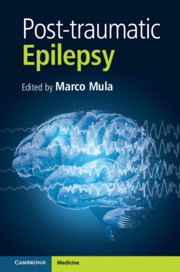Book contents
- Post-traumatic Epilepsy
- Post-traumatic Epilepsy
- Copyright page
- Contents
- Contributors
- Foreword
- Preface
- Chapter 1 Neurobiological Aspects of Post-traumatic Epilepsy: Lessons from Animal Models
- Chapter 2 Post-traumatic Epilepsy: Epidemiology, Definition and Terminology
- Chapter 3 Traumatic Brain Injury: The Acute Management and Prevention Programmes
- Chapter 4 Critical Care Management of Traumatic Brain Injury
- Chapter 5 Post-traumatic Epilepsy in Children
- Chapter 6 Sport-related Concussive Convulsions
- Chapter 7 Accidents and Injuries during Seizures
- Chapter 8 Cognitive Rehabilitation of Traumatic Brain Injury and Post-traumatic Epilepsy
- Chapter 9 Neuropsychiatric Consequences of Moderate to Severe Traumatic Brain Injury
- Chapter 10 Traumatic Brain Injury and Psychogenic Nonepileptic Seizures
- Chapter 11 Post-traumatic Epilepsy and Post-traumatic Stress Disorder
- Chapter 12 Antiepileptogenic Therapies for Post-traumatic Epilepsy: Is There Any Evidence?
- Chapter 13 Effects of Antiepileptic Drugs on Cognition
- Chapter 14 Post-traumatic Epilepsy in Low Income Countries
- Index
- References
Chapter 8 - Cognitive Rehabilitation of Traumatic Brain Injury and Post-traumatic Epilepsy
Published online by Cambridge University Press: 10 August 2021
- Post-traumatic Epilepsy
- Post-traumatic Epilepsy
- Copyright page
- Contents
- Contributors
- Foreword
- Preface
- Chapter 1 Neurobiological Aspects of Post-traumatic Epilepsy: Lessons from Animal Models
- Chapter 2 Post-traumatic Epilepsy: Epidemiology, Definition and Terminology
- Chapter 3 Traumatic Brain Injury: The Acute Management and Prevention Programmes
- Chapter 4 Critical Care Management of Traumatic Brain Injury
- Chapter 5 Post-traumatic Epilepsy in Children
- Chapter 6 Sport-related Concussive Convulsions
- Chapter 7 Accidents and Injuries during Seizures
- Chapter 8 Cognitive Rehabilitation of Traumatic Brain Injury and Post-traumatic Epilepsy
- Chapter 9 Neuropsychiatric Consequences of Moderate to Severe Traumatic Brain Injury
- Chapter 10 Traumatic Brain Injury and Psychogenic Nonepileptic Seizures
- Chapter 11 Post-traumatic Epilepsy and Post-traumatic Stress Disorder
- Chapter 12 Antiepileptogenic Therapies for Post-traumatic Epilepsy: Is There Any Evidence?
- Chapter 13 Effects of Antiepileptic Drugs on Cognition
- Chapter 14 Post-traumatic Epilepsy in Low Income Countries
- Index
- References
Summary
Individuals with TBI are vulnerable to a range of cognitive impairments that can interact with psychological comorbidities to lead to chronic challenges with social and occupational functioning in the community. Epilepsy is similarly associated with cognitive difficulties that can be further undermined by the medical, psychological, and psychosocial sequelae of the illness. Although there are limited empirical studies specifically examining cognition in PTE to date, emerging evidence suggests that the development of seizures after TBI may result in a “double hit” to cognitive functioning. This chapter outlines the cognitive sequelae of TBI and epilepsy, and presents a model of cognitive impairment in PTE. It reviews the scant literature on the cognitive consequences of PTE, highlighting current gaps in the literature. Finally, it describes an approach to cognitive rehabilitation in PTE, based on the well-established principles in TBI adapted to accommodate the unique challenges of PTE.
Keywords
- Type
- Chapter
- Information
- Post-traumatic Epilepsy , pp. 104 - 127Publisher: Cambridge University PressPrint publication year: 2021
References
- 1
- Cited by

